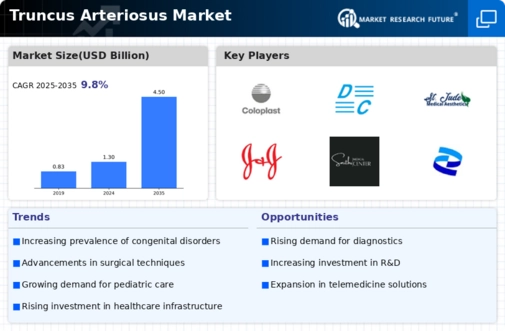Market Growth Projections
The Global Truncus Arteriosus Market Industry is poised for significant growth, with projections indicating a market value of 1.3 USD Billion in 2024 and an anticipated increase to 4.5 USD Billion by 2035. This growth trajectory suggests a compound annual growth rate of 11.95% from 2025 to 2035. Such figures underscore the increasing demand for effective treatments and interventions for truncus arteriosus, driven by factors such as rising incidence rates, advancements in surgical techniques, and enhanced healthcare infrastructure. The market's expansion reflects a broader trend towards improved cardiac care and the ongoing commitment to addressing congenital heart defects on a global scale.
Government Initiatives and Funding
Government initiatives and funding play a crucial role in the development of the Global Truncus Arteriosus Market Industry. Various health organizations and government bodies are increasingly allocating resources towards research and development of treatments for congenital heart defects. For example, funding for clinical trials and public health campaigns aimed at early detection and intervention has been on the rise. These initiatives not only enhance awareness but also facilitate the development of innovative therapies and surgical techniques. Consequently, the market is expected to grow at a compound annual growth rate of 11.95% from 2025 to 2035, reflecting the positive impact of these governmental efforts.
Increasing Awareness and Education
The Global Truncus Arteriosus Market Industry benefits from heightened awareness and education regarding congenital heart defects. Educational campaigns aimed at healthcare professionals and the general public are crucial in promoting early diagnosis and treatment options. As more individuals become informed about truncus arteriosus, the likelihood of timely medical intervention increases, which can significantly improve patient outcomes. This growing awareness is likely to contribute to the market's expansion, as more patients seek specialized care. The emphasis on education and awareness is expected to drive the market value, aligning with the projected growth trajectory in the coming years.
Advancements in Surgical Techniques
Innovations in surgical techniques and technologies are pivotal in shaping the Global Truncus Arteriosus Market Industry. Minimally invasive procedures and improved surgical methodologies have enhanced patient outcomes and reduced recovery times. For instance, the adoption of robotic-assisted surgeries has shown promising results in treating truncus arteriosus, leading to shorter hospital stays and lower complication rates. These advancements not only improve the quality of care but also increase the number of patients eligible for surgical interventions. As a result, the market is likely to witness substantial growth, with a projected value of 4.5 USD Billion by 2035, driven by these technological improvements.
Rising Incidence of Congenital Heart Defects
The Global Truncus Arteriosus Market Industry is experiencing growth due to the increasing prevalence of congenital heart defects, particularly truncus arteriosus. Statistics indicate that congenital heart defects affect approximately 1 in 100 live births worldwide. This rising incidence necessitates enhanced medical interventions and surgical procedures, thereby driving demand for specialized healthcare services and products. As awareness and diagnosis improve, more cases are identified, contributing to the market's expansion. The projected market value for truncus arteriosus treatment is expected to reach 1.3 USD Billion in 2024, reflecting the urgent need for effective solutions in this area.
Emerging Markets and Healthcare Infrastructure Development
Emerging markets are becoming increasingly relevant in the Global Truncus Arteriosus Market Industry due to their expanding healthcare infrastructure. Countries with developing economies are investing in healthcare facilities and services, which enhances access to treatment for congenital heart defects. As these nations improve their healthcare systems, the demand for specialized cardiac care is expected to rise. This trend is particularly evident in regions such as Asia-Pacific and Latin America, where healthcare investments are surging. The growth potential in these markets is substantial, contributing to the overall expansion of the industry as it adapts to meet the needs of diverse populations.





















Leave a Comment